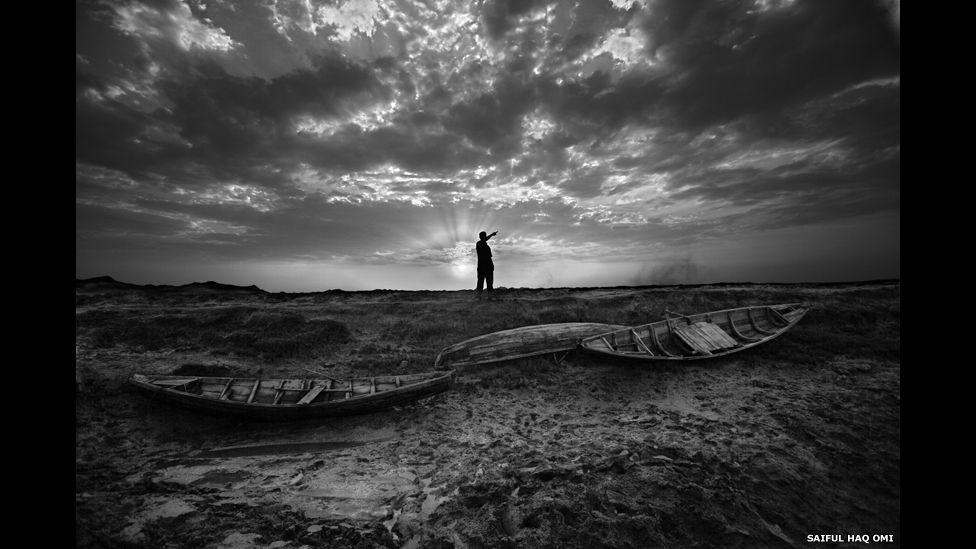In pictures: Refugee stories
- Published

The UN says the Rohingya people, who live in western Burma, also known as Myanmar, are one of the most persecuted minorities in the world. Photographer Saiful Huq Omi says these "few words from [Rohingya refugee] John made me take a step back". "You just cross the river Naaf and there is my home by the riverside. From here it is just two miles, but for me it is like two million miles, a distance I will never be able to cross. My mother is there, my home is there. It is close for someone like you, those who have passports, and who can go anywhere they want."
Photographer Sam Phelps says: "I crouched on the makeshift tent floor across from Fane, a 70-year-old grandmother sheltering at L’Ecole Liberty in the town of Bossangoa, Central African Republic. She talked and cried surrounded by her family’s belongings, those that they were able to grab before anti-Balaka militants had destroyed their home weeks before."
American photojournalist Lynsey Addario says: "Music drifts out into the otherwise silent camp, and inside the home of Yousra, 16, handfuls of radiant girls and women pump their palms up into the air and undulate around the room in celebration of today’s marriage. After almost a year of covering Syrian refugees in Turkey, Lebanon, Jordan, Iraq, and at camps for the internally displaced in Syria, I finally witness a scene of joy. For a brief few hours, I imagine what their lives might have been like back at home."
Photographer Frederic Noy says: "A few weeks ago I went to Cameroon to photograph the arrival of Central African refugees fleeing the violence in their country. Taken during this mission, the photo that I have picked symbolises for me the plight of refugees. A Central African child sleeps on a mat. Although visibly marked by hunger, he still remains slender and graceful. This picture suggests to the viewers what words would have a hard time describing - the violence of the conflict in Central Africa, the exile, the willingness to live, deeply ingrained in his vulnerable body."
Sebastian Rich, a British photographer and cameraman says: "In a camp in Maban County, South Sudan, a young girl of about seven years had been following me around as I photographed daily life. Every now and then a tiny warm hand would hold me gently by the wrist. I looked down to see her intently studying several butterflies. My interpreter, Mohammad, told me, 'She is saying it is so dirty in the camp with all the dust that she would like to take the butterflies from your arms and put them in her pockets to keep the wings clean and soft.'"
Andrew McConnell, who photographed 102-year-old Syrian refugee Saada, says: "Saada is a resilient woman. She lost seven of her 10 children at a young age, her husband 13 years ago and now, her country. Even when the bombing started in her home region, she just continued with her daily routine. 'I was sitting outside, sorting the olives and the plane was above me. They called and yelled from the house for me to come inside, but I told them, ‘Why? The plane doesn’t want anything from me. I am not going to fight it with olives.''"
British photojournalist Jason Tanner says: "I’d spent the better part of two years procrastinating about how I would approach and photograph the subject of sexual violence in conflict. Producing ‘anonymous’ portraits, to protect identity is one of the most challenging skills asked of a photographer. Maria’s [not her real name] harrowing testimony and circumstances of the interview reminded me of the duty of care, the responsibility and obligation we have as photographers to repay the trust, the risks, and sometimes the bravery afforded to us by refugees."
Helene Caux on assignment in Burkina Faso for the United Nations High Commissioner for Refugees, says: " I was about to give up taking photographs in this excruciating environment and to ask for hospitality in a refugee’s hut, when I saw this little girl standing still in front of me, as the sand storm was raging. I later learnt that her name was Assafa and that she was six years old. Assafa was relocated with her family and all the refugees of Damba camp to another nearby camp, in Mentao. She continues to go to school. 'I want to become a teacher,' she says. 'And I want to go back to my home in Mali.'"
Photographer Evelyn Hockstein says: "Naima’s uncle was murdered in Ethiopia for his involvement in the Oromo movement. Her parents fled to Kenya as political refugees, before relocation to California. Today, Naima [pictured with her son] works as a caseworker at the IRC [International Rescue Committee] in Atlanta. 'I enjoy working with my clients,' she said. 'I see my parents and I see myself in them.' Naima plans to focus on women’s health and well-being to empower refugee women to have a voice."
Photographer Phil Behan says: "What immediately struck me was this woman’s age. Her name is Rasoul and at 75 years old she was forced to flee her home due to sectarian violence in Burma’s Rakhine State. After I took the photo of her, I thought to myself, 'How does someone of this age cope with such a situation?' Imagine, if you can, your own grandmother living such a fate, and then perhaps you can understand how hard displacement is." All photos: Courtesy UNHCR
Related Internet Links
The BBC is not responsible for the content of external sites.